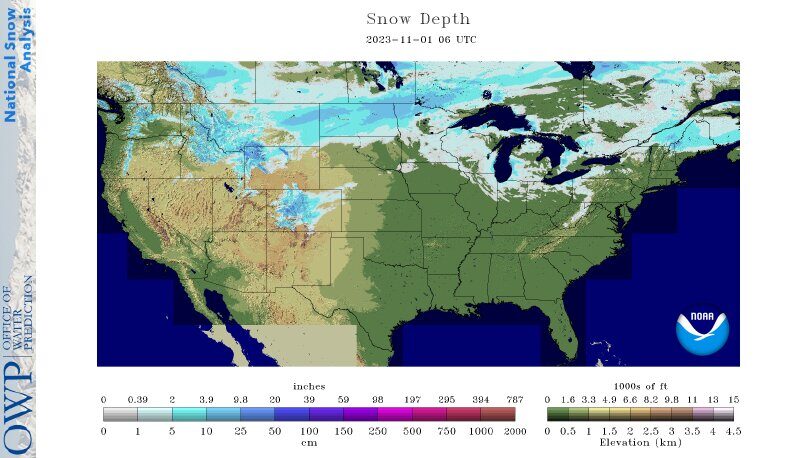
© NOAA NOHRSCSnow depth as of Wednesday.
The season's first snows have frosted the Rocky Mountains, the northern Plains, the Great Lakes and northern New England over the past week, resulting in the most extensive early-November snow cover in at least two decades.
On Wednesday morning, snow was on the ground in 17.9 percent of the Lower 48, according to the National Oceanic and Atmospheric Administration.
Locations from eastern Minnesota to western New York saw snow on Halloween — even enough to shovel in Minneapolis; Milwaukee; Muskegon, Mich.; and Buffalo. Areas downwind of Lakes Erie and Ontario were also blanketed early Wednesday, including Cleveland and Akron, Ohio, while several inches were anticipated along some of the west-facing slopes of the Appalachian Mountains.
This latest batch of wintry weather comes on the heels of two other storm systems that brought snow to the Mountain West, the northern Plains, the Midwest and northern New England over the past week.
Record-setting cold fuels early-season snowThe current abundance of snow was made possible by a powerful early-season outbreak of cold air. It brought a handful of
record lows in the northern Plains on Halloween and in areas to the south and east of there on Wednesday morning.
About 119 million Americans began Wednesday at or below freezing; the temperature averaged over the Lower 48 was 31.3 degrees — more than 10 degrees below average.Numerous locations across Texas, Oklahoma, Kansas and Missouri flirted with or broke record lows Wednesday morning. This included a teeth-chattering 8 degrees in Mount LeConte, Tenn., in the Smoky Mountains — the location's
earliest single-digit low on record.A series of stormsWintry weather started suddenly last week as a storm exited the Pacific Northwest after delivering deep powder to the mountains. The storm went on to blanket the zone from Montana to North Dakota with 6 to 12 inches of snow, while also dragging cold air southward.
A second storm developed in the Rockies over the weekend, burying the Denver region in 4 to 10 inches; up to several feet fell in the mountains to the west, kicking off the ski season at several resorts. This storm also produced snows across the northern Midwest, the Great Lakes and northern New England.
A third atmospheric disturbance produced snow from the northern Plains to the Great Lakes on Halloween and is still going.Minneapolis opened Halloween with 2 to 4 inches of snow, while much of Minnesota and Wisconsin saw light accumulations. Milwaukee received about 3 inches, and Chicago got an inch. The Muskegon area, on the eastern shore of Lake Michigan, saw about 10 inches.
By Wednesday morning, snow was furiously falling downwind of Lake Erie, affecting Cleveland as well as much of northeast Ohio and northwest Pennsylvania. Through midday, 2 to 6 inches had fallen in the region, with an additional 1 to 3 inches possible. Snow was also falling in the
mountains of the Mid-Atlantic on Wednesday, with
accumulating snow in western Maryland and flurries as far east as Baltimore's suburbs.
Snow also extended north through Buffalo and Rochester, N.Y., as well as
parts of the Berkshires on Wednesday.
The resultsThese three storm systems together have covered 17.9 percent of the Lower 48 in snow, the most to start November since such records began in 2003, according to NOAA.Last year on Nov. 1, snow covered just 3.4 percent of the Lower 48. The 20-year average snow cover over the Lower 48 on Nov. 1 is 5.5 percent.
Several locations have posted historically significant snowfall for this early in the season. With 14 inches through Oct. 31, Glasgow, Mont., has registered its snowiest start to the season on record. Bismarck, N.D., which posted 9.1 inches through the end of last month, has seen its fourth-greatest amount of snow through this date.
Will it last?All this may leave one wondering if this early blast of snow and cold will stick around. Judah Cohen, a seasonal forecasting expert with Verisk Atmospheric and Environmental Research, said probably not.
"I expect a pretty hasty retreat of snow cover back into Canada," Cohen told
The Washington Post. "It will be interesting to see how much snow can last until the next buildup of Arctic air."
Computer models suggest that warmer-than-normal conditions will replace the wintry weather over the next week or two. A lot of the snow outside the mountains will probably melt away pretty quickly.
Now, the HAARP weather control system is being deployed by Obama / Biden to create a very early and harsh winter, which will kill many, especially those weakened by the mRNA vaccine...!
God help us all.